U.S. Immigration and Customs Enforcement
The U.S. Immigration and Customs Enforcement (ICE) is a federal law enforcement agency under the U.S. Department of Homeland Security. ICE's stated mission is to protect America from the cross-border crime and illegal immigration that threaten national security and public safety.[2][3]
| U.S. Immigration and Customs Enforcement | |
|---|---|
ICE logo | |
 HSI Special Agent badge | |
 ERO Officer badge | |
| Motto | "Protecting National Security and Upholding Public Safety" HSI’s motto: Honor, Service, Integrity |
| Agency overview | |
| Formed | March 1, 2003 |
| Preceding agency |
|
| Employees | 20,000+ (2016) |
| Annual budget | $7.6 billion (FY 2018)[1] |
| Jurisdictional structure | |
| Operations jurisdiction | United States |
| Specialist jurisdictions | |
| Operational structure | |
| Headquarters | 500 12th Street SW Washington, D.C., U.S. |
| Agency executives |
|
| Parent agency | United States Department of Homeland Security |
| Website | |
| www | |
This mission is executed through the enforcement of more than 400 federal statutes and focuses on immigration enforcement, preventing terrorism and combating the illegal movement of people and goods.[4][5] ICE has two primary components: Homeland Security Investigations (HSI) and Enforcement and Removal Operations (ERO).
ICE maintains attachés at major U.S. diplomatic missions overseas. ICE does not patrol American borders; rather, that role is performed by the United States Border Patrol, a unit of U.S. Customs and Border Protection, which is a sister agency of ICE.[6][7][8]
The agency has not had a Senate-confirmed director since Sarah Saldaña stepped down on January 20, 2017.[9] The former Acting Director of ICE, Matthew Albence, began on April 13, 2019. On May 5, 2019, President Donald Trump announced via Twitter that he would nominate Mark Morgan to succeed Albence,[10] and Morgan assumed office as Acting Director on May 28, 2019. On June 27, 2019, it was announced Morgan will leave to become Acting Commissioner of U.S. Customs and Border Protection on July 5, 2019. Albence resumed his role as Acting Director on July 5, 2019.[11]
History

U.S. Immigration and Customs Enforcement was formed under the Homeland Security Act of 2002, following the events of September 11, 2001. With the establishment of the Department of Homeland Security, the functions and jurisdictions of several border and revenue enforcement agencies were combined and consolidated into U.S. Immigration and Customs Enforcement. Consequently, ICE is the largest investigative arm of the Department of Homeland Security and the second largest contributor to the FBI's Joint Terrorism Task Force.
The agencies that were either moved entirely or merged in part into ICE included the criminal investigative and intelligence resources of the United States Customs Service, the criminal investigative, detention and deportation resources of the Immigration and Naturalization Service, and the Federal Protective Service. The Federal Protective Service was later transferred from ICE to the National Protection and Programs Directorate effective October 28, 2009. In 2003, Asa Hutchinson moved the Federal Air Marshals Service from the Transportation Security Administration (TSA) to ICE,[12] but Michael Chertoff moved them back to the TSA in 2005.[13]
In April 2006, ICE's Cyber Crimes Center, Child Exploitation Section, initiated an investigation into criminal organizations that distributed child pornography.[14] The project, dubbed Operation Flicker, found that there were a number of government employees, including "dozens of Pentagon staff and contractors with high-level security clearance," who had downloaded child pornography.[15]
Organization
U.S. Immigration and Customs Enforcement is responsible for identifying and eliminating border, economic, transportation, and infrastructure security vulnerabilities. There is an estimate of about 20,000 ICE employees in approximately 400 offices within the United States and 53 countries.[16]
The organization is composed of two law enforcement directorates (HSI and ERO) and several support divisions each headed by a director who reports to an Executive Associate Director.[17] The divisions of ICE provide investigation, interdiction and security services to the public and other law enforcement partners in the federal and local sectors.
The Director of ICE is appointed at the sub-cabinet level by the President of the United States, confirmed by the U.S. Senate, and reports directly to the Secretary of Homeland Security.[18][19]
Structure
- Director (until July 2010 the title had been "Assistant Secretary")[20]
- Deputy Director
- Enforcement and Removal Operations
- Removal Division
- Secure Communities and Enforcement Division
- Immigration Health Services Division
- Mission Support Division
- Detention Management Division
- Local Field Offices
- Homeland Security Investigations
- Domestic Operations Division
- Intelligence Division
- International Operations Division
- Mission Support
- National Intellectual Property Rights Coordination Center
- National Security Investigations Division
- Management and Administration
- Enforcement and Removal Operations
- Deputy Director
Homeland Security Investigations (HSI)
_training_using_armored_vehicle.jpg)
HSI consists of more than 10,300 employees who are assigned to over 210 cities throughout the U.S. and 80 international offices in 53 countries across the world. Over 7,100 special agents are included among the over 10,300 HSI employees.
HSI special agents investigate violations of more than 400 U.S. laws that threaten the national security of the United States such as counter-proliferation; counter-terrorism; human smuggling and trafficking; weapons smuggling and export enforcement; narcotics smuggling and trafficking; document and benefit fraud; the manufacturing, sale, and use of counterfeit immigration and identity documents; human rights violations; transnational gang activity; financial crimes, including money laundering and bulk cash smuggling; cyber crime; exploitation of children and sex tourism; trade crimes such as commercial fraud and intellectual property theft; smuggling of counterfeit pharmaceuticals and other merchandise; mass-marketing fraud; art theft; international cultural property and antiquities crimes; and visa security.[21] HSI agents can be requested to provide security for VIPs, and also augment the U.S. Secret Service during overtaxed times such as special security events and elections.
HSI was formerly known as the ICE Office of Investigations (OI). HSI special agents investigate the largest range of crimes and have the statutory authority to enforce the Immigration and Nationality Act (Title 8), U.S. customs laws (Title 19), general federal crimes (Title 18), the Controlled Substances Act (Title 21), as well as Titles 5, 6, 12, 22, 26, 28, 31, 46, 49, and 50 of the U.S. Code.
Intelligence
The Office of Intelligence is a subcomponent of HSI that employs a variety of special agents and Intelligence Research Specialists to facilitate HSI's tactical and strategic intelligence demands. Collectively, these intelligence professionals collect, analyze, and disseminate intelligence for use by the operational elements of DHS. The Office of Intelligence works closely with the intelligence components of other federal, state, and local agencies. Many HSI field offices assign intelligence analysts to specific groups, such as financial crimes, counter-proliferation, narcotics, or document fraud; or they can be assigned to a residential intelligence unit, known as a Field Intelligence Group (FIG). HSI agents assigned to FIGs generally focus on Human Intelligence (HUMINT) collection.
International Operations

International Operations, formerly known as the Office of International Affairs (OIA), is a subcomponent of HSI with agents stationed in 60 locations around the world. HSI's foreign offices, known as Attaché Offices, work with foreign governments to identify and combat transnational criminal organizations before they threaten the United States. IO also facilitates domestic HSI investigations by providing intelligence from host countries, conducting collateral investigations, and facilitating international investigations conducted by field offices within the United States.
Special Response Teams
Seventeen HSI field offices maintain a Special Response Team (SRT) that operates as a federal SWAT element for the office's area of responsibility (AOR).[22] SRT was founded under the U.S. Customs Service as the Warrant Entry and Tactical Team (WETT) and were renamed to SRT in 1998.[22] The SRT handles HSI's high-risk arrest and search warrants, barricaded subjects, rural area operations, VIP protection, sniper coverage for high-risk operations, and security for National Security Events. HSI's active SRTs are located in Tampa, Miami, Arizona (Phoenix), New Orleans, Houston, New York, Boston, Dallas, Los Angeles, San Antonio, San Juan, Detroit, San Francisco, El Paso, Chicago, San Diego and Washington, D.C. There is also a team of instructors and coordinators stationed full-time in Columbus, Georgia. These teams primarily deploy to handle high-risk operations, but also assist in events such as Hurricane Katrina, the Haiti earthquake 2010, and other natural disasters around the globe.
SRT is a collateral duty open to HSI special agents assigned to an office with a certified team. To qualify, candidates must pass a physical fitness test, qualify with multiple firearms by shooting 90% or better in full tactical gear, and pass an oral interview process. If a candidate passes these stages and is voted on the local team, they are then designated "Green Team" members and allowed to train with the certified team members. Green Team members are eventually sent to the SRT Initial Certification Course at the Office of Firearms and Tactical Programs, Tactical Operations Unit (OFTP/TOU) Fort Benning, Georgia, where they must pass additional physical fitness, firearms, scenario-based and written assessments.[23] Out of approximately 7,100 special agents, there are currently only approximately 300 certified SRT members nationwide.
HSI SRTs often conduct training exercises with various federal, state and local teams, and also assist other teams during national events or large-scale operations that require multiple high-risk scenarios to be conducted simultaneously. The working relationship between the SRTs and the U.S. Department of Defense's U.S. Special Operations Command has led to SOCOM providing the SRTs with excess Mine Resistant Ambush Protected Vehicles (MRAPs), firearms, and other gear designed for the U.S. Tier One groups.
Enforcement and Removal Operations (ERO)
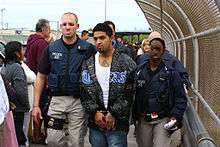
ERO is responsible for enforcing the nation's immigration laws and ensuring the departure of removable immigrants from the United States. ERO uses its detention and deportation officers to identify, arrest, and remove immigrants who violate U.S. immigration law. Deportation officers are responsible for the transportation and detention of immigrants in ICE custody to include the removal of immigrants to their country of origin. Deportation officers arrest immigrants for violations of U.S. immigration law, monitor cases during deportation proceedings, supervise released immigrants, and remove immigrants from the United States.[24]
Deportation officers operate strategically placed Fugitive Operations Teams whose function is to locate, apprehend, and remove immigrants who have absconded from immigration proceedings and remain in the United States with outstanding warrants for deportation.
ERO manages the Secure Communities program which identifies removable immigrants located in jails and prisons. Fingerprints submitted as part of the normal criminal arrest and booking process will automatically check both the Integrated Automatic Fingerprint Identification System (IAFIS) of the FBI's Criminal Justice Information Services (CJIS) Division and the Automated Biometric Identification System (IDENT) of the Department of Homeland Security's US-VISIT Program.
ERO was formerly known as the Office of Detention and Removal Operations (DRO).
Other divisions
The Office of State, Local and Tribal Coordination (OSLTC) is ICE's primary outreach and communications component for state, local and tribal stakeholders. It is responsible for building and improving relationships, and coordinating activities with state, local, territorial, and tribal law enforcement agencies and through public engagement. It also fosters and sustains relationships with federal, state and local government officials and coordinates ICE ACCESS programs (Agreements of Cooperation in Communities to Enhance Safety and Security).
The Office of the Principal Legal Advisor (OPLA) provides legal advice, training and services to support the ICE mission and defends the interests of the United States in the administrative and federal courts.
The Office of Professional Responsibility is responsible for investigating allegations of misconduct involving employees of ICE.
ICE Air is the aviation division of ICE that charters aircraft or books commercial flights to send deportees back to their home countries.[25][26] There are 10 aircraft used to send deportees and has a working list of 185 countries.[26] Deportees have legs and arms secured while boarding, handcuffs are removed during flight and all shackles removed upon disembarking.
ICE Health Service Corps (IHSC) is a division that is responsible for providing direct patient care to approximately 13,500 detainees housed in 21 detention facilities throughout the nation.[27] Their stated mission is to provide the best care to those in ICE custody, practicing on the core values of Integrity, Commitment, Accountability, Service, and Excellence.[28] The IHSC team is made up of around 1,000 members that consist of US Public Health Service Commissioned Corps officers, healthcare professionals, and federal civil service workers.[29]
Former units
The Federal Air Marshal Service (FAMS) was aligned into ICE shortly after the creation of the Department of Homeland Security. On October 16, 2005, Homeland Security Secretary Michael Chertoff officially approved the transfer of the Federal Air Marshal Service from the Bureau of Immigration & Customs Enforcement (ICE) to the TSA as part of a broader departmental reorganization to align functions consistent with the Department of Homeland Security (DHS) "Second Stage Review" findings for:
- consolidating and strengthening aviation law enforcement and security at the Federal level;
- creating a common approach to stakeholder outreach; and
- improving the coordination and efficiency of aviation security operations.
As part of this realignment, the Director of the Federal Air Marshal Service also became the Assistant Administrator for the TSA Office of Law Enforcement (OLE), which houses nearly all TSA law enforcement services.
The Federal Protective Service (FPS) was moved from the General Services Administration (GSA) to ICE upon the creation of the Department of Homeland Security (DHS). The FPS was later moved out of ICE to the National Protection Programs Directorate.
Originally a part of the U.S. Customs Service's Office of Investigations, the Office of Air and Marine (then called the Air and Marine Interdiction Division) was transferred to ICE in 2003 during the creation of the Department of Homeland Security, becoming the Office of Air and Marine Operations. Due in part to a 500 million dollar budgetary dispute between CBP and ICE, in 2004 ICE Air and Marine Operations was transferred to U.S. Customs and Border Protection. CBP Air and Marine still works closely with ICE to support the agency's domestic and international law enforcement operations.[30][31][32][33]
The Office of Detention Policy and Planning was responsible developing and maintaining ICE's National Detention Standards, which set out detailed rules for how immigration detainees were to be treated differently than criminal inmates.[34] In April 2017, President Donald Trump decided to close the office and to stop including the standards in new jail contracts.[34]
Assistant Secretaries and Directors
| No. | Picture | Name | Took office | Left office | President |
|---|---|---|---|---|---|
| Assistant Secretary | |||||
| 1 |  |
Michael J. Garcia | March 2003 | September 2005 | George W. Bush |
| – | John P. Clark | September 2005 | January 2006 | ||
| 2 |  |
Julie Myers | January 4, 2006 | November 14, 2008 | |
| – |  |
John P. Torres | November 17, 2008 | May 12, 2009 | |
| Barack Obama | |||||
| Director | |||||
| 3 |  |
John T. Morton | May 12, 2009 | July 31, 2013 | Barack Obama |
| – | .jpg) |
John Sandweg | August 1, 2013 | February 21, 2014 | |
| – |  |
Thomas Winkowski Acting as Principal Deputy Assistant Secretary |
March 16, 2014 | December 23, 2014 | |
| 4 |  |
Sarah Saldaña | December 23, 2014 | January 20, 2017 | |
| – |  |
Daniel Ragsdale | January 20, 2017 | January 30, 2017 | Donald Trump |
| – | 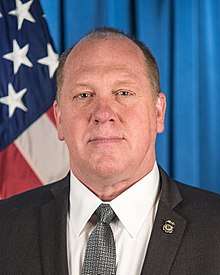 |
Thomas Homan | January 30, 2017 | June 29, 2018 | |
| – | | |
Ronald Vitiello | June 30, 2018 | April 12, 2019 | |
| – | 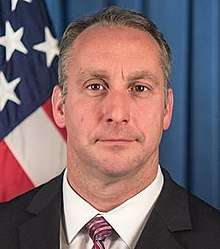 |
Matthew Albence | April 13, 2019 | May 27, 2019 | |
| – |  |
Mark Morgan | May 28, 2019 | July 5, 2019 | |
| – |  |
Matthew Albence | July 5, 2019 | Present | |
Training
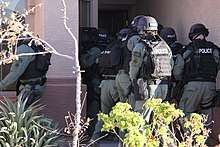
Newly hired ICE law enforcement personnel receive their training at the Federal Law Enforcement Training Centers in Glynco, Georgia. To meet division specific academic and practical instruction, the ICE Academy varies in length from 4 to 6 months depending on the position. Furthermore, following graduation, all ICE law enforcement personnel undergo additional post academy training, as well as career-continuous training. Specific course curriculum is kept confidential, but both ERO and HSI new hires undergo training related to basic law enforcement tactics, immigration law, firearms training, emergency response driving, and Constitutional law. HSI special agents also receive training regarding U.S. customs law, warrant service, advanced tactics, undercover operations, criminal interrogation, weapons of mass destruction, and other subjects routinely encountered by HSI special agents in the field. ERO deportation officers undergo several weeks of intensive Spanish language training prior to graduating.
Weapons and equipment
Since the agency's formation, a variety of weapons have been carried by its Agents and Officers.
Previously-issued firearms
Initially when the agency was formed in 2003, the sidearms issued to its Agents and Officers were the weapons issued by the legacy agencies: the U.S. Customs Service and the U.S. Immigration and Naturalization Service. The USCS issued sidearm was the Glock 19 9mm pistol. The I&NS issued sidearm was the Heckler & Koch USP Compact .40 caliber pistol. Both pistols were loaded with hollow-point rounds.[35]
In 2009 the agency selected the SIG-Sauer P229 DAK (double action Kellerman) .40 caliber pistol as its agency issued sidearm loaded with hollow-point rounds. This weapon stayed in service from 2009 to 2020.[36]
Sidearms
The agency's current duty sidearm, is the SIG Sauer P320C (C for Carry) pistol, chambered in 9×19mm Parabellum hollow-point rounds, utilizing a striker-fired mechanism in lieu of a double action only hammer system.[37]
The agency has a list of personally owned weapons that are authorized for duty and off duty carry. These weapons must be inspected and approved by the agency’s firearms unit. The agent and/or officer must qualify with the weapon once a quarter.[38]
Other weapons
Agents and Officers are trained on standard shoulder fired weapons that include the M4 carbine, chambered for 5.56×45mm NATO ammunition and the 12-gauge Remington 870 shotgun.[38]
As non-lethal options, Special Agents and Officers are armed with the expandable metal baton and pepper spray.[38]
Transnational gangs
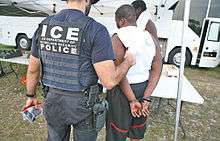
In February 2005, ICE began Operation Community Shield, a national law enforcement initiative that targets violent transnational street gangs through the use of ICE's broad law enforcement powers, including the unique and powerful authority to remove criminal immigrants, including illegal immigrants and legal permanent residents.[39][40]
Immigration law
Immigration and Nationality Act Section 287(g) allows ICE to establish increased cooperation and communication with state, and local law enforcement agencies. Section 287(g) authorizes the Secretary of Homeland Security to enter into agreements with state and local law enforcement agencies, permitting designated officers to perform immigration law enforcement functions, pursuant to a Memorandum of Agreement (MOA), provided that the local law enforcement officers receive appropriate training and function under the supervision of sworn U.S. Immigration and Customs Enforcement officers. Under 287(g), ICE provides state and local law enforcement with the training and subsequent authorization to identify, process, and when appropriate, detain immigration offenders they encounter during their regular, daily law-enforcement activity.[41]
The 287(g) program is one of several ICE ACCESS (ICE "Agreements of Cooperation in Communities to Enhance Safety and Security") programs that increase collaboration between local law enforcement and immigration enforcement agents.[42]
HSI has played a key role in investigating and arresting citizens suspected of possessing and distributing child pornography.[43]
Detention centers
ICE operates detention centers throughout the United States that detain illegal immigrants who are apprehended and placed into removal proceedings. About 34,000 people are held in immigration detention on any given day,[44] in over 500 detention centers, jails, and prisons nationwide.[45]
Due to the United States detention bed quota, mandated by Congress, that number will increase rather than decrease. The quota mandates at least 34,000 beds available for immigrants on any given day.[46][47] Under the Trump administration, the number of people being detained on any given day has increased to 52,500.[48]
Corporate contracts
Engineering and construction firm Kellogg, Brown and Root (KBR) released a press statement on January 24, 2006, that the company had been awarded a no-bid contingency contract from the Department of Homeland Security to support its ICE facilities in the event of an emergency. The maximum total value of the contract is $385 million and consists of a one-year base period with four one-year options. KBR held the previous ICE contract from 2000 through 2005. The contract provides for establishing temporary detention and processing capabilities to expand existing ICE Detention and Removal Operations Program facilities in the event of an emergency influx of immigrants into the U.S., or to support the rapid development of new programs. The contract may also provide migrant detention support to other government organizations in the event of an immigration emergency, the company said.[49]
Criticisms
Protests
Numerous protests have emerged across the nation in response to the Trump administration's ICE policies. Many of the protesters are occupying areas around ICE facilities in hopes of disrupting operations. The Occupy ICE movement began on June 17, 2018, outside Portland, Oregon. It initially began as a vigil for the people suffering from ICE policies but spontaneously grew into a larger movement as more people showed up. The movement ultimately spread into other major cities like Philadelphia, San Francisco, San Diego, and New York. As the movement grew, they faced counter protesters and arrests, but protesters remained undeterred and vowed to continue fighting the Trump administration's ICE policies. As Occupy ICE groups spread to different cities, there has also been a greater amount of coordination between them.[50] Other grassroots protests have sprung up across the nation as well. On August 1, 2019, a month-long peaceful protest event was started outside the San Francisco ICE office, where protesters beat drums and demanded that family separation at the border be stopped.[51] In addition to blocking ICE facilities, protesters are also protesting technology companies such as Microsoft for providing technology to aid ICE. One such instance of this was the sit in at the Microsoft store on 5th Avenue in NYC led by Close the Camps NYC on September 14, 2019.[52]
Sexual abuse
The Intercept published a report by the DHS Office of Inspector General revealing that 1,224 sexual abuse complaints while in immigration custody were filed between January 2010 and June 2017. Contrary to ICE's claims, only 2% of these complaints were investigated.[53][54]
Record number of deportations
Between 2009 and 2016, the Barack Obama administration oversaw the deporting of a record 2.4 million immigrants, earning him the nickname "Deporter-In-Chief" by Janet Murguía, the president of National Council of La Raza.[55][56] According to ICE data, about 40% of those deported by ICE in 2015 had no criminal conviction, while majority of those convicted were guilty of minor charges.[57] However, this statistic is misleading, as the way in how deportations were counted was changed under the Bush administration and continued under the Obama administration. Before, people caught crossing the southern border were simply bused back and were not counted as deportations. However, with the change, these people were fingerprinted and added to the deportation tally, giving the Obama administration a record number of deportations.[58]
Separation of migrant children from their families

As part of the 2018 Trump administration's zero tolerance policy, nearly 3,000[59] minors were separated from their parents, or the adults accompanying them, while trying to illegally cross the U.S.-Mexico border and placed in detention camps.[60][61] Rolling Stone likened these centers to "prisons" while The Houston Chronicle reported that a movement swelled online to call them "concentration camps."[62][63] Similarly, former First Lady of the United States Laura Bush compared the images of the centers to U.S. Japanese internment camps during the Second World War.[64] 16 out of 34[65] of the centers located in Texas had previously been cited by Texas officials for more than 150 health violations.[66] The former head of US Immigration and Customs Enforcement, John Sandweg, was critical of child separation, telling NBC News, "You could easily end up in a situation where the gap between a parent's deportation and a child's deportation is years," and that many children might never see their parents again.[67]
In addition, detained children are now being given up for adoption. In a series of court cases, foster families were successfully able to gain full custody of migrant children that they were housing without notifying their parents.[68] Most notably, the agency Bethany Christian Services, an agency that facilitates the care of foster children in Michigan has been under fire for trying to promote the adoption of these migrant children instead of trying to reunite them with their families. In a previous Facebook post, they had waived the previous $550 international adoption application fee for the month of June.[69] This had led to public outcry and protests have been held against this agency and their practices.[70]
This policy in particular has led to the Abolish ICE movement gaining traction in June 2018.
Detention of U.S. citizens
From 2012 to early 2018, ICE wrongfully arrested and detained 1,488 U.S. citizens, including many who spent months or years in immigration detention.[71] A 2018 Los Angeles Times investigation found that ICE's reliance on incomplete and error-prone databases and lax investigations led to the erroneous detentions.[71] From 2008 to 2018, ICE was sued for wrongful arrest by more than two dozen U.S. citizens, who had been detained for periods ranging from one day to over three years. Some of the wrongfully detained U.S. citizens had been arrested by ICE more than once.[71] The inaccurate government data that ICE used had shown that both immigrants and U.S. citizens were both targets of being detained. In 2019, a U.S. citizen that was detained stated that he lost 26 pounds from the horrendous conditions that the detention center offered.[72]
Sanctuary cities
Sanctuary cities are cities that limit their cooperation with ICE. When a person is arrested, his or her information is placed into a federal database that ICE can access. In a non-sanctuary city, ICE can ask the police to hold the illegal immigrant until they can pick him or her up. However, sanctuary cities believe this is unconstitutional and view being an illegal immigrant as not a crime but a civil violation. As such, the top officials of sanctuary cities prevent the police from holding an illegal immigrant for being undocumented by policy or ordinance. Notwithstanding, illegal immigrants in police custody have committed criminal violations unrelated to illegal immigration that landed them in jail.[73] Sanctuary cities are one of the many focal points for the Trump administration's attempts to reform the country's immigration policies. In early 2017, President Trump issued an executive order to deny sanctuary cities federal grants if they did not comply with ICE.[74] By November 2017, this order was struck down by the United States District Court for the Northern District of California.[75] Despite this, the Trump administration has continued to seek ways to challenge sanctuary cities, such as implementing policy that preferentially awards policing grants that cooperate with ICE.[76]
See also
- Asylum shopping
- Dillingham Commission
- Diplomatic Security Service (DSS)—U.S. Department of State
- Drug Enforcement Administration
- Federal Air Marshal Service
- Federal Protective Service (U.S.)
- List of United States federal law enforcement agencies
- Operation Endgame
- Operation Front Line
- Operation Protect Our Children
- Operation Tangled Web
- Title 19 of the Code of Federal Regulations
- United States Border Patrol
- U.S. Customs and Border Protection
- United States Citizenship and Immigration Services
- U.S. Marshals Service
- U.S. Secret Service
- Jaime Zapata (U.S. agent)
Comparable international agencies
- Australian Border Force
- Canada Border Services Agency
- Immigration Enforcement – a Home Office division in the United Kingdom
- Customs Surveillance Service – Spain (only customs enforcement; immigration issues are handled by the standard National Police and Guardia Civil)
- Frontex – European Union (Schengen Area)
- Federal Migration Service (FMS) – Russia
References
- Cristobal Ramón, Interior Enforcement Under the Trump Administration by The Numbers: Part One, Removals, Bipartisan Policy Project (June 19, 2019).
- "What We Do". U.S. Immigration and Customs Enforcement. U.S. Department of Homeland Security. Retrieved July 14, 2019.
- "Enforcement and Removal Operations". U.S. Immigration and Customs Enforcement. U.S. Department of Homeland Security. Retrieved July 14, 2019.
- "What We Do | ICE". U.S. Immigration and Customs and Enforcement. Department of Homeland Security. Retrieved July 30, 2018.
- "Enforcement and Removal Operations". U.S. Immigration and Customs Enforcement. U.S. Department of Homeland Security. Retrieved April 9, 2019.
- Nixon, Ron; Qiu, Linda (July 3, 2018). "What Is ICE and Why Do Critics Want to Abolish It?". The New York Times. Retrieved July 5, 2018.
- "Calls to Abolish ICE Not 'Open Borders'". FactCheck.org. Annenberg Public Policy Center. July 3, 2018. Retrieved July 5, 2018.
- Folley, Aris (June 29, 2018). "ICE chief to protesters: We're not the ones separating families". Retrieved July 5, 2018.
- Kanno-Youngs, Zolan; Tackett, Michael (May 5, 2019). "Trump Names Mark Morgan, Former Head of Border Patrol, to Lead ICE". The New York Times. ISSN 0362-4331. Retrieved May 6, 2019.
- Alvarez, Priscilla (April 11, 2019). "ICE acting deputy director tapped to lead agency". CNN. Retrieved May 6, 2019.
- Uria, Daniel (June 27, 2019). "Mark Morgan to replace John Sanders as acting U.S. border chief". UPI. Retrieved July 12, 2019.
- Goo, Sara Kehaulani; Goo, Sara Kehaulani (June 19, 2003). "Air Marshals Seek a Flight Out of TSA to New Agency" – via washingtonpost.com.
- ""The Federal Air Marshal Service will be moved from the Immigration and Customs Enforcement (ICE) bureau to the Transportation Security Administration"".
- ICE FOIA Case Number 2015-ICFO-82330 (2016). Retrieved from https://documents.theblackvault.com/documents/controversies/USICE-FLICKER.pdf on 10/2/2019
- MacAskill, E.(2010) Pentagon workers found to have downloaded child pornography. The Guardian. Retrieved from https://www.theguardian.com/world/2010/jul/24/pentagon-us-staff-downloaded-child-pornography on 10/2/2019
- "Who We Are | ICE". Ice.gov. March 25, 2016. Retrieved June 14, 2017.
- "ICE Leadership". Ice.gov. January 1, 1970. Retrieved September 27, 2010.
- "Leadership: Assistant Secretary John T. Morton". U.S. Immigration and Customs Enforcement. May 21, 2009. Archived from the original on May 27, 2010. Retrieved August 9, 2009.
- "Leadership". U.S. Immigration and Customs Enforcement. June 21, 2014. Retrieved June 21, 2014.
- "John T. Morton is appointed assistant secretary of U.S. Immigration and Customs Enforcement". U.S. Immigration and Customs Enforcement. Retrieved June 25, 2017.
- Mejia, Brittny (March 19, 2019). "ICE's investigative arm fears it might have a branding problem". Los Angeles Times. Retrieved March 19, 2019.
- James, Nathan (September 3, 2015). Federal Tactical Teams (Report). Congressional Research Service. CRS Report for Congress, R44179.
- "Special response teams prep for high risk situations at Ft. Benning". U.S. Immigration and Customs Enforcement (Press release). November 30, 2011. Retrieved September 12, 2017.
- "ICE Office of Detention and Removal (ERO) ICE Detention and Deportation Officer Conrad Agagan". Ice.gov. Archived from the original on May 27, 2010. Retrieved September 27, 2010.{
- "ICE Air Operations". www.ice.gov. Retrieved October 23, 2019.
- "A rare look inside a deportation flight – CNN Video".
- "ICE Health Service Corps". www.ice.gov. Retrieved October 30, 2019.
- "ICE Health Service Corps". www.ice.gov. Retrieved November 13, 2019.
- "ICE Health Service Corps". www.ice.gov. Retrieved October 30, 2019.
- "2000 Archived Press Releases". Customs and Border Protection. March 16, 2001. Archived from the original on December 23, 2004. Retrieved June 18, 2013.
- "Management Mess – Features – Magazine". GovExec.com. March 1, 2006. Retrieved June 18, 2013.
- "CBP Today – October/November 2004 – Welcome Air and Marine Operations". Customs and Border Protection. October 31, 2004. Archived from the original on October 23, 2011. Retrieved June 18, 2013.
- "Wasted Year". GovExec.com. March 2006. Retrieved June 18, 2013.
- Dickerson, Caitlin (April 14, 2017). "Trump Plan Would Curtail Protections for Detained Immigrants". The New York Times. p. A1. Retrieved April 15, 2017.
- Former I&NS Special Agent
- Staff, G&A (January 3, 2011). "Department Of Homeland Security Chooses SIG's DAK". Shooting Times.
- "It is official: ICE tells employees the Sig 320 is their new gun". NEWSREP. 24 February 2017. Retrieved 11 June 2019. https://sofrep.com/news/official-ice-tells-employees-sig-320-new-gun/"It is official: ICE tells employees the Sig 320 is their new gun". NEWSREP. 24 February 2017. Retrieved 11 June 2019. Check
|url=value (help). Missing or empty|title=(help) - HSI Special Agent
- "investigations national security - Immigration and Customs Enforcement (ICE) Search Results". www.ice.gov. Archived from the original on May 5, 2009.
- "Operation targets criminal immigrant gangs". msnbc.com. March 11, 2006. Retrieved July 23, 2018.
- Budzinski, Joe (September 30, 2006). "287g training from ICE sought by many U.S. jurisdictions – novatownhall blog". Novatownhall.com. Archived from the original on March 8, 2012. Retrieved September 27, 2010.
- "Office of State and Local Coordination: ICE ACCESS". Ice.gov. Archived from the original on May 27, 2010. Retrieved September 27, 2010.
- "Teacher faces charges of pornography". MassLive.com. November 29, 2006. Archived from the original on March 7, 2012. Retrieved September 27, 2010.
- Bernstein, Nina. "In-Custody Deaths". New York Times. Retrieved May 26, 2010.
- Anil Kalhan (2010). "Rethinking Immigration Detention". Columbia Law Review Sidebar. 110: 42–58. SSRN 1556867.
- "Detention Bed Quota". National Immigrant Justice Center. Retrieved July 5, 2018.
- "Little-Known Immigration Mandate Keeps Detention Beds Full". NPR.org. Retrieved June 11, 2018.
- "24 immigrants have died in ICE custody during the Trump administration". NBC News. Retrieved November 21, 2019.
- "KBR Awarded U.S. Department of Homeland Security Contingency Support Project for Emergency Support Services". www.businesswire.com. Business Wire. January 24, 2006. Retrieved February 18, 2020.
- Gabbatt, Adam (July 6, 2018). "The growing Occupy Ice movement: 'We're here for the long haul'". The Guardian. ISSN 0261-3077. Retrieved October 23, 2019.
- "Peaceful protest held following overnight arrests at ICE headquarters in San Francisco". ABC7 San Francisco. August 2, 2019. Retrieved October 23, 2019.
- Amir Vera. "76 anti-ICE protesters arrested during New York sit-in". CNN. Retrieved October 23, 2019.
- "Immigration detention and sexual abuse". Retrieved June 15, 2018.
- "At Largest ICE Detention Center in the Country, Guards Called Attempted Suicides "Failures"".
- "Low-Priority Immigrants Still Swept Up in Net of Deportation". The New York Times. June 25, 2016. Retrieved June 15, 2018.
- "National Council Of La Raza Dubs Obama 'Deporter-In-Chief'". NPR. March 4, 2014. Retrieved June 15, 2018.
- Young, Elliott (February 27, 2017). "The Hard Truths About Obama's Deportation Priorities". HuffPost. Retrieved June 15, 2018.
- "Were More People Deported Under the Obama Administration Than Any Other?". Snopes.com. Retrieved November 14, 2019.
- "The Trump administration just admitted it doesn't know how many kids are still separated from their parents". Vox. Retrieved July 6, 2018.
- Touchberry, Ramsey (June 15, 2018). "Almost 45 children a day are being taken from their families and placed in immigrant detention centers: Report". Newsweek.
- Kendzior, Sarah (June 17, 2018). "The unspeakable cruelty of Trump's child-migrant camps". The Globe and Mail. Retrieved June 19, 2018.
- Bort, Ryan (June 14, 2018). "This Is the Prison-Like Border Facility Holding Migrant Children". Rolling Stone. Retrieved June 19, 2018.
- Ramirez, Fernando (June 15, 2018). "Movement to call migrant detention centers 'concentration camps' swells online". The Houston Chronicle.
- Bush, Laura (June 17, 2018). "Opinion Laura Bush: Separating children from their parents at the border 'breaks my heart'". Washington Post. ISSN 0190-8286. Retrieved June 19, 2018.
- "Shelters for immigrant children near capacity in Texas". KHOU. Retrieved June 19, 2018.
- Touchberry, Ramsey (June 12, 2018). "Texas immigrant children shelters had 150 health violations in the past year". Newsweek.
- Joseph, Rebecca (June 19, 2018). "Separations of children, parents at U.S. border could be permanent: Former immigration director". GlobalNews.
- "No, the Government Did Not Make the Deadline to Reunify Children With Their Parents". doi:10.1163/2210-7975_hrd-9970-20180211. Cite journal requires
|journal=(help) - Joyce, Kathryn (July 1, 2018). "The Threat of International Adoption for Migrant Children Separated From Their Families". The Intercept. Retrieved October 30, 2019.
- "Protests as children separated from families at border now in Bethany Christian Services' foster care". Fox17. June 20, 2018. Retrieved October 30, 2019.
- Paige St. John & Joel Rubin, ICE held an American man in custody for 1,273 days. He's not the only one who had to prove his citizenship, Los Angeles Times (April 27, 2018).
- "18-year-old U.S. citizen detained by border officials said conditions were so bad he lost 26 pounds within the 23 days that he was detained, and almost self-deported". www.cbsnews.com. Retrieved October 31, 2019.
- Voice, Americas's (April 25, 2017). "Immigration 101: What is a Sanctuary City?". America's Voice. Retrieved October 31, 2019.
- "Executive Order: Enhancing Public Safety in the Interior of the United States". The White House. Retrieved October 23, 2019.
- Offutt, Lindsay. "Federal judge strikes down Trump's executive order withholding funding from sanctuary cities". www.jurist.org. Retrieved October 31, 2019.
- Press, The Associated (July 12, 2019). "Trump Administration Gets Court Victory in Sanctuary Cities Case". The New York Times. ISSN 0362-4331. Retrieved October 31, 2019.
External links
| Wikimedia Commons has media related to U.S. Immigration and Customs Enforcement. |
- Official website
- U.S. Immigration and Customs Enforcement in the Federal Register
- U.S. Customs and Border Protection
- International agencies comparable to ICE
